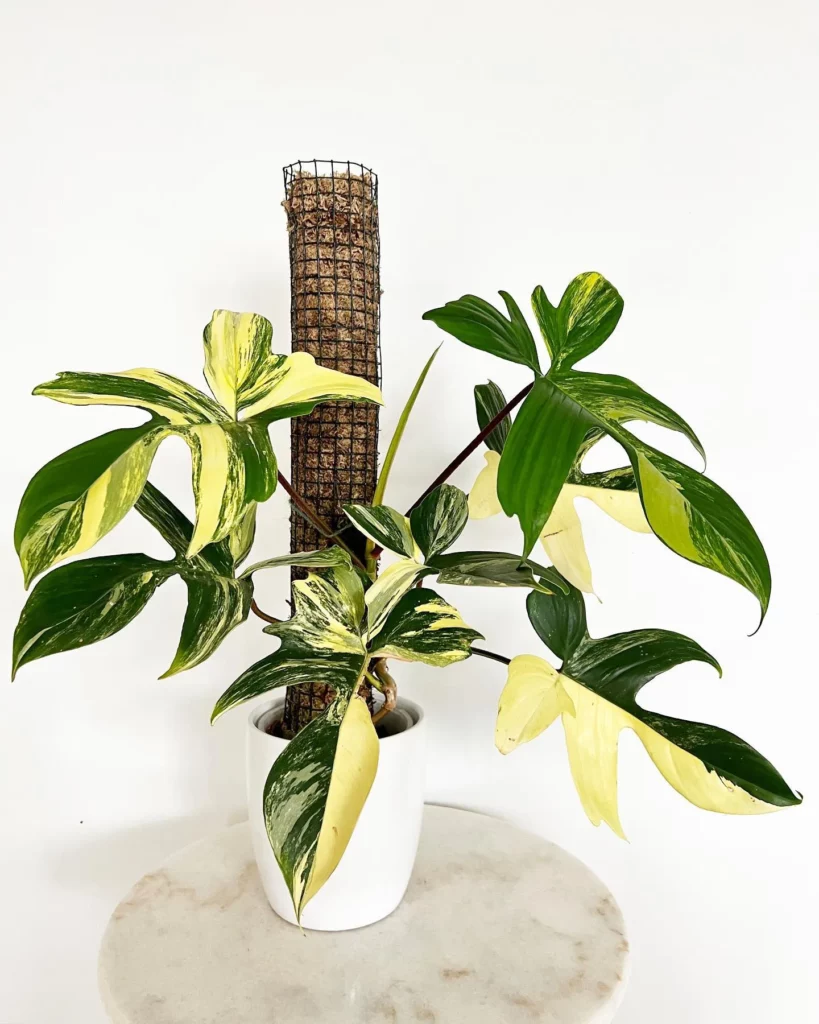Philodendron can transform your home into an oasis of lush greenery. Philodendrons are renowned for their beauty and are perfect for indoor spaces. In this comprehensive guide, we will walk you through the nurturing process to help you achieve stunning growth and bring out the full potential of this indoor beauty.
Related Articles: 76 Types of Philodendron & How to Split a Philodendron
Appearance of Philodendrons



Philodendrons are known for their diverse and eye-catching appearance. These indoor plants come in various shapes, sizes, and colors, adding a touch of natural beauty to any space. The defining feature of philodendrons is their large, green, and glossy foliage, which gives them a vibrant and lush appearance.
There are two main types of philodendrons: climbing and non-climbing. Climbing philodendrons, like the popular Philodendron hederaceum var. oxycardium, are perfect for hanging baskets or trailing out of containers. Non-climbing philodendrons, such as the Philodendron bipinnatifidum, have large leaves and grow from a single growing tip at the base of the plant.
Light Requirements for Philodendrons



If you want your philodendron to thrive, it’s important to provide it with the right amount of light. Philodendrons prefer indirect light conditions or shady areas, especially if you live in zones 10b to 11. Direct sunlight can be too intense for these plants and may cause their delicate leaves to burn. To create the ideal environment for your philodendron’s growth, place it near a sunny window where it can receive bright indirect light for most of the day.
By positioning your philodendron in a location with indirect light, you ensure that its foliage remains healthy and vibrant. These beautiful indoor plants do best when they receive just the right amount of light, allowing them to thrive and flourish in your home.
| Light Conditions | Suitable Locations |
|---|---|
| Bright Indirect Light | Near a sunny window |
| Shady Areas | Rooms with limited direct sunlight |
Watering Philodendrons
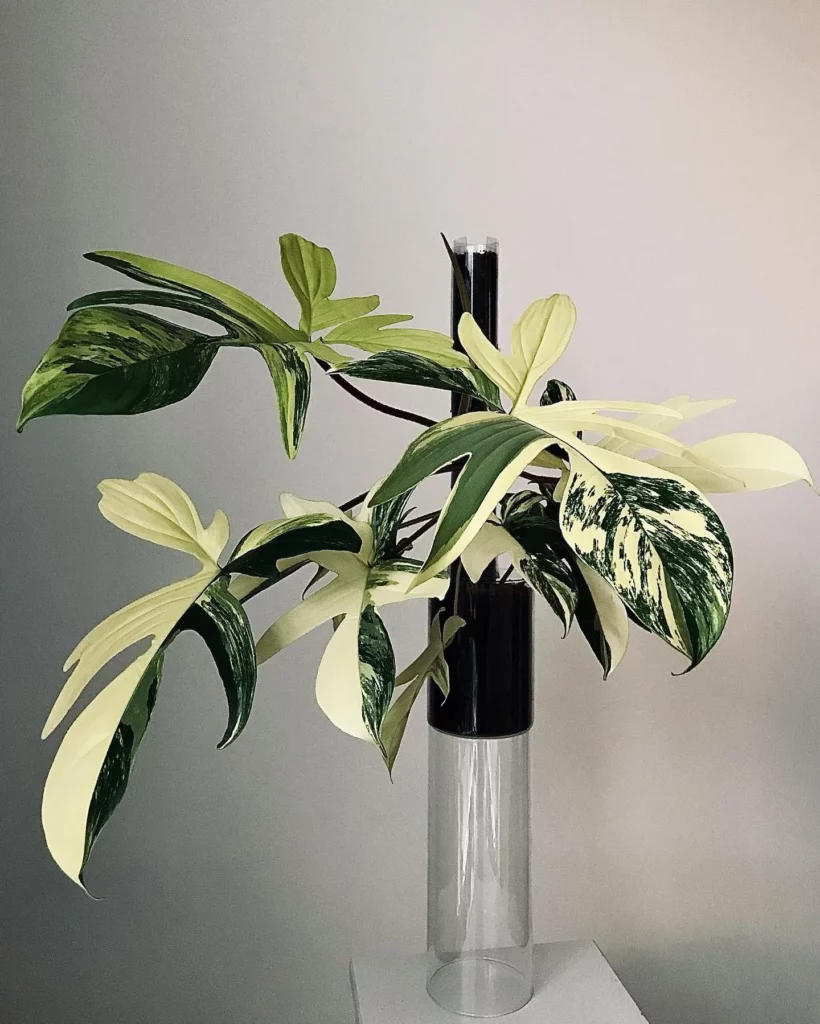


Proper watering is essential for the health of your philodendron. Philodendrons prefer soil that is consistently moist but not soggy. The key is to find the right balance to ensure optimal growth.
A general rule of thumb is to water your philodendron when the top inch of soil feels dry to the touch. This indicates that the plant is ready for a drink. However, be cautious of overwatering, as it can lead to root rot and other issues.
On the other hand, underwatering should also be avoided. If you let the soil dry out too much, the leaves may wilt and curl, affecting the plant’s overall health.
To maintain the ideal moisture level, it’s important to regularly check the soil dryness. Stick your finger about an inch into the soil to assess whether it’s time to water. If it feels dry, it’s time to water. If it feels moist, you can wait a bit longer.
When watering, make sure to thoroughly saturate the soil until water starts to flow out of the drainage holes. This ensures that the entire root system receives adequate moisture. Avoid letting your philodendron sit in standing water, as this can lead to root rot. Empty any excess water from the saucer or tray to prevent waterlogged soil.
Signs of Overwatering vs. Underwatering
| Signs of Overwatering | Signs of Underwatering |
|---|---|
| Yellowing leaves | Wilting and curling leaves |
| Mushy or rotten roots | Dry and brittle leaves |
| Musty or foul odor | Leaves losing their green color |
Fertilizing Philodendrons



When it comes to fertilizing philodendrons, using a balanced liquid fertilizer is recommended. This type of fertilizer provides a mix of macro and micronutrients that are crucial for healthy plant development.
It is best to apply the fertilizer once a month during the spring and summer months when philodendrons are actively growing. This helps to replenish the soil nutrients and support the plant’s overall health and vigor.
Regular fertilizing with a balanced liquid fertilizer will promote lusher leaves, stronger stems, and more robust root systems in your philodendron. It will also enhance the overall appearance and vitality of the plant, contributing to its visual appeal in your home.
Recommended Fertilizer for Philodendrons
| Fertilizer Name | NPK Ratio | Application Frequency |
|---|---|---|
| Miracle-Gro Pour & Feed Plant Food | 12-4-8 | Monthly during spring and summer |
| Scotts Liquid Gold All Purpose Plant Food | 10-10-10 | Monthly during spring and summer |
| Jobe’s Organics All Purpose Fertilizer | 4-4-4 | Monthly during spring and summer |
Note: The NPK ratio represents the percentage of nitrogen (N), phosphorus (P), and potassium (K) in the fertilizer, respectively. These are the primary macronutrients necessary for plant growth.
Potting Philodendrons

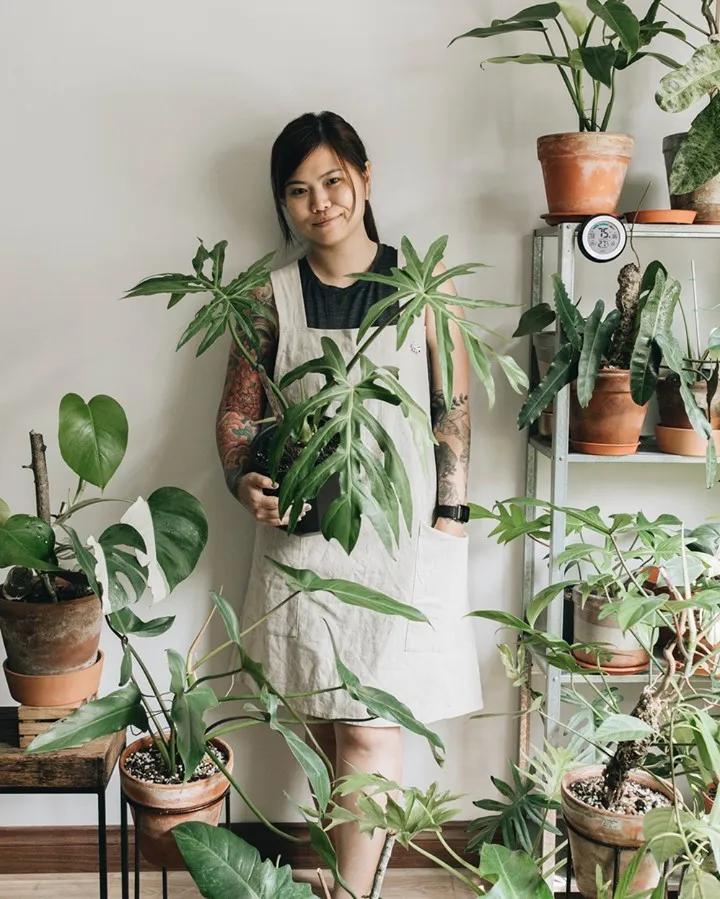

When it comes to potting your philodendron, there are a few key considerations to keep in mind. The right pot size, well-draining potting mix, and proper repotting techniques are essential for the health and growth of your plant.
Choosing the Right Pot Size
It’s important to choose a pot that is 1 to 2 inches larger in diameter than the root ball of your philodendron. This allows enough room for the roots to expand and prevents the pot from becoming overcrowded. A pot that is too large can lead to excessive moisture retention, potentially causing root rot.
Using a Well-Draining Potting Mix
When potting your philodendron, opt for a well-draining potting mix to ensure proper water drainage. A popular choice is the Miracle-Gro® Indoor Potting Mix, which is specifically formulated for indoor plants. This mix helps prevent waterlogging, which can be detrimental to the philodendron’s root system.
Repotting When Necessary
Repotting should only be done when necessary or when the philodendron has outgrown its current pot. Signs that your plant may need repotting include roots growing through the drainage holes, stunted growth, yellowing leaves, or water running straight through the soil without soaking in.
When repotting, gently remove the plant from its old pot, taking care not to disturb the roots. Position the plant in the new pot so that the top of the root ball is about ¾ to 1 inch below the top of the container. Fill in around the root ball, ensuring that the potting mix is firmly packed but not compacted.
After repotting, water the plant thoroughly to help settle the new soil and encourage proper root establishment.
| Potting Philodendrons | Tips |
|---|---|
| Choose a pot 1 to 2 inches larger than the root ball | – Allows room for root growth |
| Use a well-draining potting mix | – Prevents waterlogging |
| Repot only when necessary | – Look for signs such as roots growing through holes, stunted growth, or yellowing leaves |
| Position plant ¾ to 1 inch below top of the new pot | – Provides room for watering and prevents spillage |
| Water thoroughly after repotting | – Helps settle new soil and promote root establishment |
Propagating Philodendrons



Philodendrons can be propagated through stem cuttings or division. Each method has its advantages and can be successful in creating new philodendron plants.
Stem Cuttings
Stem cuttings are a popular method for propagating philodendrons. To propagate through stem cuttings, follow these steps:
- Select a healthy 6-inch portion of a stem with at least two leaves.
- Using a sharp, clean knife or pruners, make a clean cut just below a node (the point where a leaf is attached to the stem).
- Remove any leaves from the lower portion of the cutting, leaving two or three leaves at the top.
- Place the cutting in a glass of water and ensure the lower portion is submerged.
- Put the glass in a bright area with indirect light.
- Change the water every few days to prevent stagnation and promote root development.
- After roots develop, usually within a few weeks, pot the cutting in moist, well-draining soil.
Note: While using a rooting hormone can increase the success rate of rooting for stem cuttings, it is not necessary for all varieties of philodendrons.
Division
Division is another effective method for propagating philodendrons. Here’s how to propagate through division:
- To divide a philodendron, start by selecting a mature plant with multiple stems or plantlets.
- Gently remove the plant from its pot, taking care not to damage the roots.
- Inspect the root system and identify natural divisions or plantlets that can be separated.
- Using a sharp, clean knife or pruners, carefully separate the plantlets or divisions from the main plant, ensuring each has its own roots.
- Plant each division or plantlet in its own pot with moist, well-draining soil.
- Water thoroughly, and provide appropriate care to promote healthy growth.
| Propagation Method | Advantages |
|---|---|
| Stem Cuttings | – Allows for precise control over the propagation process. – Can produce multiple new plants from a single cutting. |
| Division | – Offers a quicker method for propagating multiple plants. – Ensures that each new plant has its own established root system. |
Growth and Development of Philodendrons



Philodendrons are renowned for their fast growth rate, a characteristic influenced by their tropical origins. These plants thrive in temperatures ranging from 65 to 85 degrees Fahrenheit, providing an ideal environment comparable to their native habitats.
To ensure optimal growth, it is crucial to provide the appropriate temperature range and prevent exposure to temperatures below 55 degrees Fahrenheit. While philodendrons can acclimate to indoor conditions, they truly flourish in a warm and humid setting that mimics their natural habitat.
Dealing with Pests and Diseases in Philodendrons



While philodendrons are generally resilient plants, they can still fall victim to common pests and diseases that affect houseplants. Regularly monitoring your philodendrons for signs of infestation and implementing preventive measures can help maintain their health and vitality.
Common Houseplant Pests
Two common pests that can infest philodendrons are aphids and mealybugs. These tiny insects can feed on the sap of the plant, causing damage to the leaves and stunting growth. To identify an infestation, look for clusters of insects, sticky residue (honeydew), or distorted leaves.
Aphids are small, soft-bodied insects that come in various colors, including green, black, and brown. They can reproduce rapidly, making it crucial to address infestations promptly. To control aphids:
- Isolate affected plants to prevent the infestation from spreading.
- Prune heavily infested parts of the plant and dispose of them properly.
- Apply insecticidal soap or a mixture of water and mild soap directly to the affected areas. Repeat as necessary.
- Introduce natural predators like ladybugs or lacewings to control aphid populations if organic methods are preferred.
Mealybugs are small, white, cottony insects that are commonly found in the leaf axils and crevices of plants. To eliminate mealybugs:
- Remove heavily infested parts of the plant and dispose of them properly.
- Use a cotton swab dipped in rubbing alcohol to directly apply it to the insects, ensuring they are thoroughly coated. Repeat this process every few days until the infestation is gone.
- Introduce natural predators such as ladybugs, parasitic wasps, or predatory mites to control mealybug populations in a natural, chemical-free way.
Disease Prevention
Preventing diseases in philodendrons begins with maintaining a healthy environment and good cultural practices. Here are some tips to help prevent common diseases:
- Clean the leaves regularly by gently wiping them with a damp cloth to remove dust and debris. This helps improve air circulation and reduces the risk of disease development.
- Provide proper ventilation to prevent excess humidity, which can create a favorable environment for fungal diseases.
- Avoid overwatering and ensure the soil has proper drainage to prevent root rot and other water-related diseases.
- Use sterile potting soil to avoid introducing pathogens into the plant’s root system.
- Monitor your plants regularly for signs of disease, such as leaf spots, wilting, or unusual growth. If you notice any issues, take immediate action to prevent further spread.
| Pest or Disease | Signs of Infestation or Infection | Treatment |
|---|---|---|
| Aphids | Clusters of tiny insects, sticky residue (honeydew), distorted leaves | Isolate plants, prune heavily infested parts, apply insecticidal soap or water and soap mixture, introduce natural predators |
| Mealybugs | Small, cottony insects found in leaf axils and crevices | Remove infested parts, use rubbing alcohol, introduce natural predators |
| Disease Prevention | Dirty or dusty leaves, lack of air circulation, overwatering | Clean leaves regularly, provide proper ventilation, avoid overwatering, use sterile potting soil, monitor plants for signs of disease |
Tips for Maintaining Philodendrons



To keep your philodendrons in optimum health, it’s important to maintain them properly. Here are some essential tips for philodendron maintenance:
1. Wiping Leaves
Regularly wipe the leaves of your philodendron with a damp cloth to remove dust and debris. This not only keeps the plant looking clean and attractive but also helps the leaves function effectively. Dust can block sunlight and inhibit the plant’s ability to photosynthesize.
2. Outdoor Exposure
During warm weather, consider occasionally placing your philodendrons outside in a shady spot. They will benefit from fresh air and natural light. However, be cautious about exposing them to direct sunlight, as it can burn their delicate leaves. Remember to bring them back indoors when temperatures drop.
3. Adjusting Watering Schedule
Monitor the soil dryness of your philodendron and adjust the watering schedule accordingly. Philodendrons prefer soil that is consistently moist but not soggy. As a general rule, water the plant when the top inch of soil feels dry. Avoid both overwatering and underwatering, as these can cause damage to the plant. Regularly checking the soil moisture is crucial for maintaining a healthy philodendron.
| Tips for Maintaining Philodendrons |
|---|
| Wiping Leaves |
| Outdoor Exposure |
| Adjusting Watering Schedule |
Tips for Successful Overwintering of Philodendrons



If you live in a non-tropical zone, overwintering your philodendrons indoors is necessary to protect them from colder temperatures. Transitioning them to indoor conditions requires some preparation, including pruning off yellowing leaves or long leggy stems and checking for pests and diseases. Providing suitable indoor temperatures, adjusting watering schedules, and ensuring proper ventilation are essential for successful overwintering of philodendrons. Following these tips will help your philodendrons survive the winter and thrive.
Growing Philodendrons from Seed



While growing philodendrons from seed is possible, it is a slow process compared to stem cuttings. If you choose to grow from seed, here is a step-by-step guide:
- Prepare rich soil: Plant the philodendron seeds in rich soil about 1/3 of an inch deep.
- Create a mini greenhouse effect: Cover the seeds with plastic to create a warm and humid environment, aiding germination.
- Optimal soil temperature: Ensure the soil temperature is between 68 and 73 degrees Fahrenheit, providing the ideal conditions for seed germination.
- Patience is key: It can take anywhere from two to eight weeks for the philodendron seeds to sprout. Be patient and maintain the right conditions.
Once the seedlings have sprouted and are sturdy enough, they can be transplanted into small pots. This will foster strong root development and ensure the philodendrons thrive.
| Propagation Method | Time Required | Difficulty Level | Success Rate |
|---|---|---|---|
| Philodendron Seed Propagation | 2-8 weeks for germination, additional time for growth | Medium | Variable |
| Stem Cuttings | Rooting in a few weeks, additional time for growth | Easy | High |
Repotting Philodendrons



Repotting philodendrons is an important step in their care routine. It should be done only when necessary to promote healthy growth and prevent root-bound plants.
There are several signs that indicate your philodendron needs repotting. If you notice roots growing through the drainage holes, stunted growth, yellowing leaves, or water running straight through the soil without soaking in, it’s time to repot.
When repotting your philodendron, choose a pot that is one size larger to provide enough space for the roots to grow. Fill the new pot with fresh potting soil, such as Miracle-Gro® Indoor Potting Mix, which offers the necessary nutrients and good drainage.
To repot your philodendron, gently remove the plant from its old pot, being careful not to disturb the roots. Place the plant in the new pot, ensuring that the top of the root ball is about ¾ to 1 inch below the top of the container. Fill in around the root ball with fresh soil, and water the plant thoroughly to help establish the new roots.
Varieties of Philodendron
There are over 100 different types of philodendron. Below we have listed some of the most popular varieties of Philodendron (feel free to click the names of the plants to learn more about them!)
Philodendron Prince of Orange

The Philodendron Prince of Orange is an excellent choice for an indoor plant due to its low maintenance requirements and adaptability to indoor environments. Thriving in moderate to low light conditions, it’s perfect for spaces that don’t receive abundant natural sunlight. Its ability to purify the air by absorbing toxins adds to its appeal for indoor settings. Furthermore, the plant’s manageable size and slow growth rate make it suitable for smaller spaces. This vibrant plant brings a touch of nature indoors without demanding extensive care, making it ideal for busy plant lovers or those new to gardening.
- The Philodendron Prince of Orange features remarkable color-changing foliage, starting as vivid orange, shifting to yellow, and ultimately turning deep green, offering a vibrant and dynamic visual element to indoor spaces.
- Its leaves are large, heart-shaped, and glossy, contributing to a lush, tropical ambiance, and enhancing the decorative appeal by reflecting light.
- The plant has a compact growth habit with leaves sprouting from a central base, making it ideally suited for small spaces like corners or tabletops.
Philodendron Burle Marx

The Philodendron Burle Marx is an exceptional choice for an indoor plant, primarily due to its resilience and ease of care. It thrives in a variety of lighting conditions, from low to bright indirect light, making it versatile for different indoor environments. This plant is also known for its air-purifying qualities, effectively removing toxins from the surroundings, thus contributing to a healthier living space. Its moderate watering needs and resistance to common pests further enhance its suitability for indoor cultivation, making it a favored choice for both novice and experienced plant enthusiasts.
- Distinctive Leaf Shape: The leaves of the Philodendron Burle Marx are long, narrow, and elegantly heart-shaped, giving it a unique and striking appearance.
- Lush Green Color: The foliage boasts a deep, rich green hue, adding a vibrant touch of nature to any indoor space.
- Cascading Growth Pattern: This plant exhibits a trailing or cascading growth habit, making it perfect for hanging baskets or high shelves where its foliage can elegantly drape downwards.
White Princess Philodendron
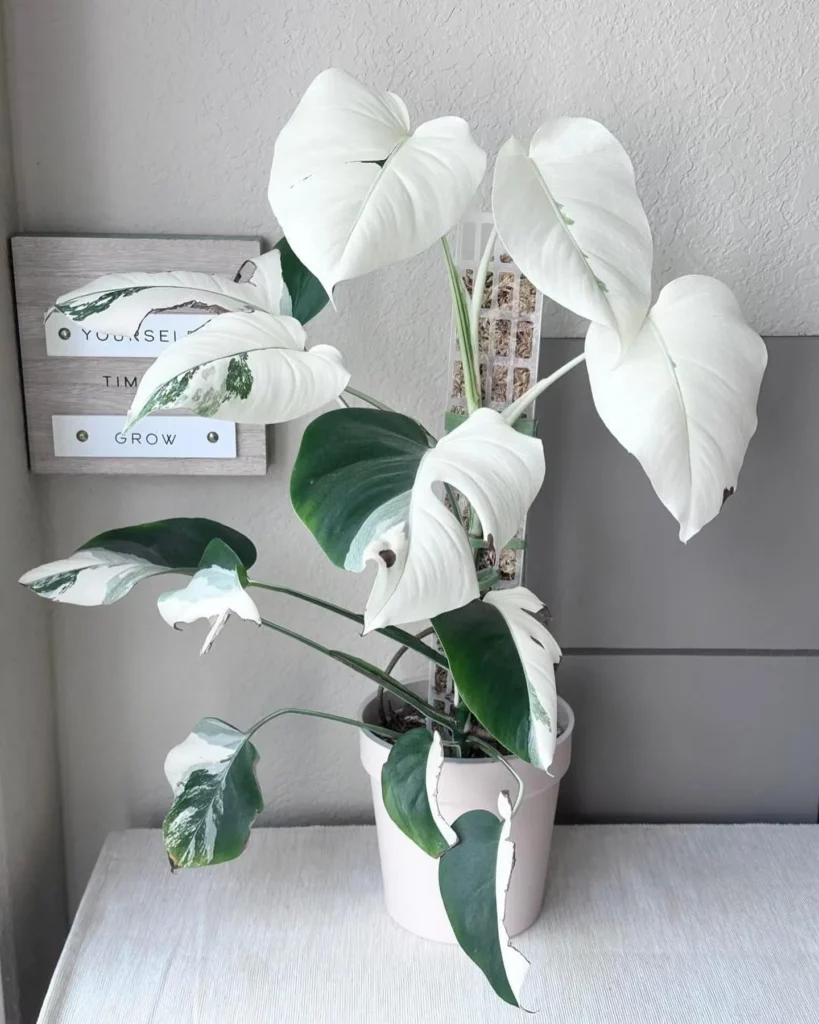
The White Princess Philodendron is highly prized as an indoor plant for several reasons. Its stunning variegated foliage, featuring a mix of green and creamy white or light pink, brings an artistic touch to any indoor setting. This variety thrives in indirect light, making it suitable for rooms that don’t receive harsh sunlight. Additionally, it’s relatively easy to care for, requiring only moderate watering and occasional feeding, which is ideal for those who want a low-maintenance yet visually striking houseplant. Its air-purifying qualities further enhance the ambiance of indoor spaces, making it a functional and aesthetic addition to homes and offices.
- Variegated Foliage: The leaves display a striking variegation of green mixed with creamy white or light pink, creating a visually appealing contrast.
- Elegant Leaf Shape: Each leaf is uniquely shaped, often heart-like or elongated, adding a sense of elegance and refinement.
- Compact Growth: The plant exhibits a compact and bushy growth habit, making it suitable for smaller spaces and ideal for creating a focal point in any room.
Philodendron Plowmanii
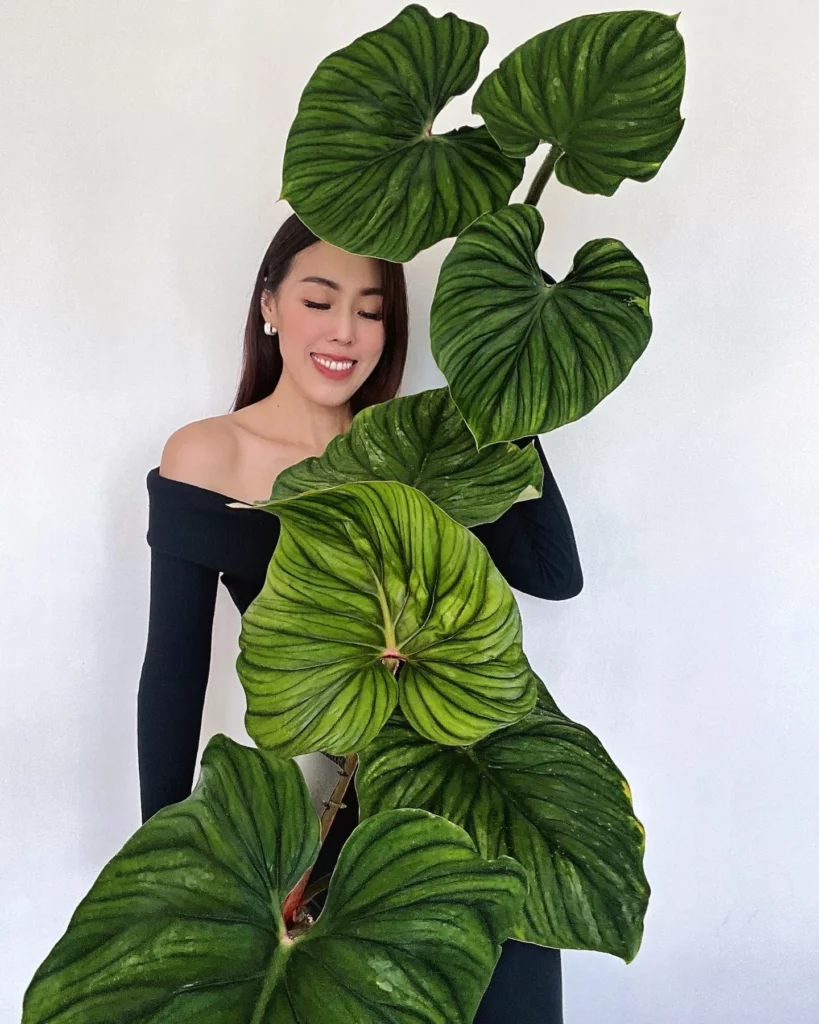
The Philodendron Plowmanii is a great indoor plant, renowned for its ease of care and stunning visual appeal. This plant is adaptable to a range of light conditions, from low to bright indirect light, making it versatile for various indoor environments. Its large, ruffled leaves not only add a touch of the tropics to any room but also have the ability to purify the air, enhancing the indoor air quality. The Philodendron Plowmanii’s resilience to common indoor plant pests and its moderate watering needs make it a low-maintenance option for plant enthusiasts of all levels.
- Ruffled Leaf Edges: The leaves are distinctively edged with a ruffled or wavy pattern, adding an interesting textural element.
- Large, Heart-Shaped Leaves: The foliage is large, heart-shaped, and verdant, giving it a lush and robust appearance.
- Long Petioles: Each leaf is supported by a long petiole (leaf stem), which allows the leaves to spread out and create an expansive, eye-catching display.
Philodendron Mamei

The Philodendron Mamei is an excellent indoor plant for several reasons. First, it thrives in low-light conditions, making it ideal for spaces that don’t receive ample sunlight. This adaptability to varying light levels ensures it can grow well in different indoor environments. Additionally, the Philodendron Mamei is known for its air-purifying qualities, as it can absorb toxins like formaldehyde from the air, contributing to a healthier indoor atmosphere. Lastly, its minimal water requirements and resistance to pests make it a low-maintenance choice, suitable even for those new to plant care or with busy lifestyles. These features collectively make the Philodendron Mamei a versatile and beneficial addition to indoor spaces.
- Heart-Shaped Leaves: The leaves of the Philodendron Mamei are distinctly heart-shaped, giving it an attractive and soft appearance.
- Silver Variegation: One of its most striking features is the silver variegation on its leaves. This creates a unique pattern of light green to silvery splotches across the leaf surface.
- Robust Growth: The plant exhibits a robust, spreading growth habit, with leaves that can grow quite large, adding a lush, green presence to any indoor setting.
Philodendron Splendid
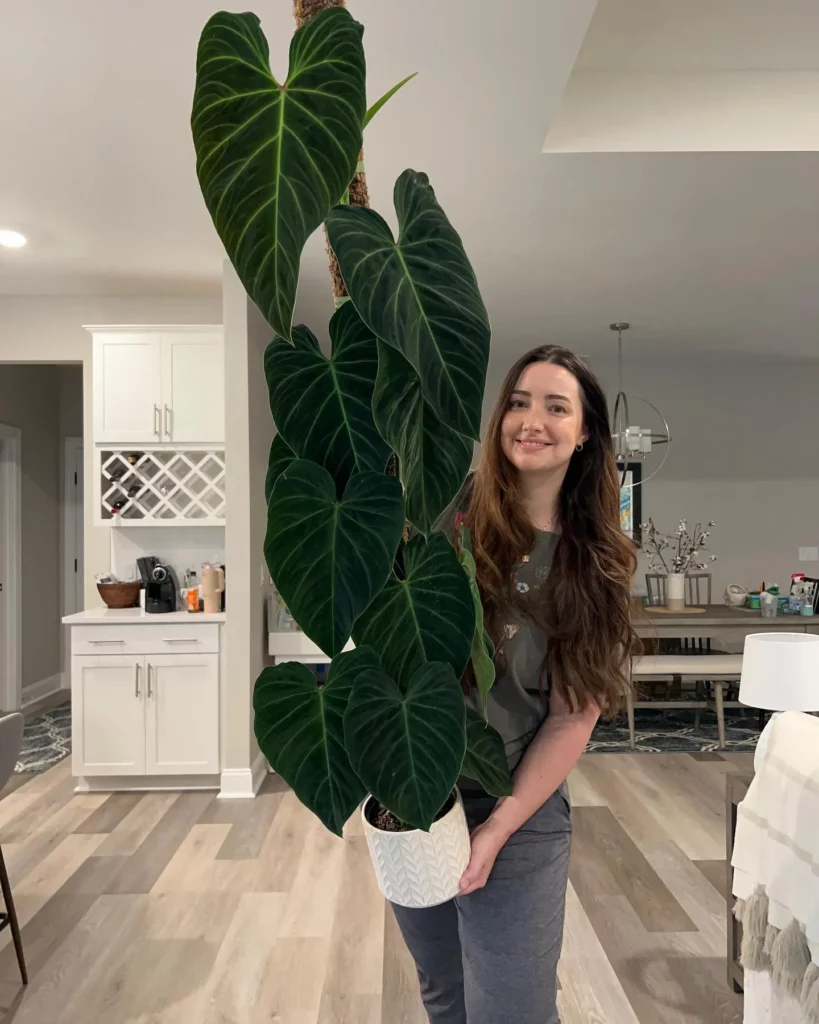
The Philodendron Splendid is an excellent choice for indoor cultivation, owing to its striking visual appeal and straightforward care requirements. This hybrid, known for its resilience, thrives in a variety of indoor lighting conditions, from low to medium indirect light, making it suitable for different room settings. Its ability to adapt to indoor climates and its moderate watering needs simplify plant care routines. The Philodendron Splendid also serves as a natural air purifier, enhancing the quality of the indoor environment. Its unique and attractive foliage adds a lush, tropical feel to any space, making it a popular choice for interior decoration.
- Striking Variegated Leaves: The plant features dark green leaves with prominent white or cream-colored variegation, creating a stunning visual contrast.
- Vining Growth Habit: It exhibits a vining growth pattern, making it ideal for climbing structures or hanging baskets, where it can elegantly cascade.
- Large, Glossy Leaves: The foliage is large, glossy, and heart-shaped, contributing to the plant’s luxurious and tropical appearance.
Philodendron Camposportoanum

The Philodendron Camposportoanum is a superb indoor plant choice, valued for its adaptability and aesthetic appeal. It prospers in a range of indoor lighting conditions, from low to bright indirect light, accommodating various home or office spaces. This plant is also appreciated for its air-purifying qualities, which help to improve indoor air quality. Easy to care for, it requires only moderate watering and is generally resilient to common houseplant pests. The Philodendron Camposportoanum’s unique foliage brings a touch of tropical elegance to any indoor setting, making it a favored plant for interior decorators and plant enthusiasts alike.
- Velvety Foliage: The leaves have a distinctive velvety texture, adding a luxurious feel to the plant’s appearance.
- Dark Green Color with Silver Accents: The foliage is primarily dark green, with subtle silver or lighter green variegation, creating an elegant contrast.
- Lance-shaped Leaves: The leaves are elongated and lance-shaped, giving the plant a sleek and sophisticated look.
Philodendron Ring of Fire

The Philodendron Ring of Fire stands out as an exceptional indoor plant due to its stunning visual appeal and adaptability to indoor conditions. This rare variety thrives in moderate to bright indirect light, making it suitable for a range of indoor environments. It’s particularly noted for its low maintenance requirements, needing only periodic watering and occasional feeding. The plant’s ability to adapt to the typical humidity levels found in homes adds to its appeal. Its dramatic foliage, with striking color variations, makes it a focal point in any room, blending aesthetic beauty with easy care.
- Vibrant Color Variations: The leaves exhibit a dramatic range of colors, including green, yellow, orange, and even shades of red, resembling a ‘ring of fire’.
- Irregular Leaf Shape: Each leaf has a unique, irregular shape with jagged edges, adding a dynamic and wild look to the plant.
- Varied Leaf Size: The foliage varies in size, creating an interesting and diverse visual texture, and contributing to the plant’s overall dramatic and fiery appearance.
Philodendron Gloriosum

The Philodendron Gloriosum is highly regarded as an indoor plant for its majestic foliage and ease of care. It thrives in indirect light conditions, making it well-suited for various indoor settings, including spaces with limited natural light. This plant is also known for its air-purifying qualities, which contribute to a healthier indoor environment. Its watering and feeding needs are moderate, appealing to both seasoned plant enthusiasts and beginners. The Philodendron Gloriosum adds a lush, tropical ambiance to any room, bringing the beauty of nature indoors with minimal effort.
- Large, Heart-shaped Leaves: The plant features oversized, heart-shaped leaves, creating a dramatic and luxurious feel.
- Velvety Texture: Each leaf has a distinctive velvety texture, which adds depth and richness to its appearance.
- Prominent White Veins: The dark green leaves are adorned with striking white veins, providing a stunning contrast and highlighting the intricate patterns of the foliage.
Philodendron Billietiae
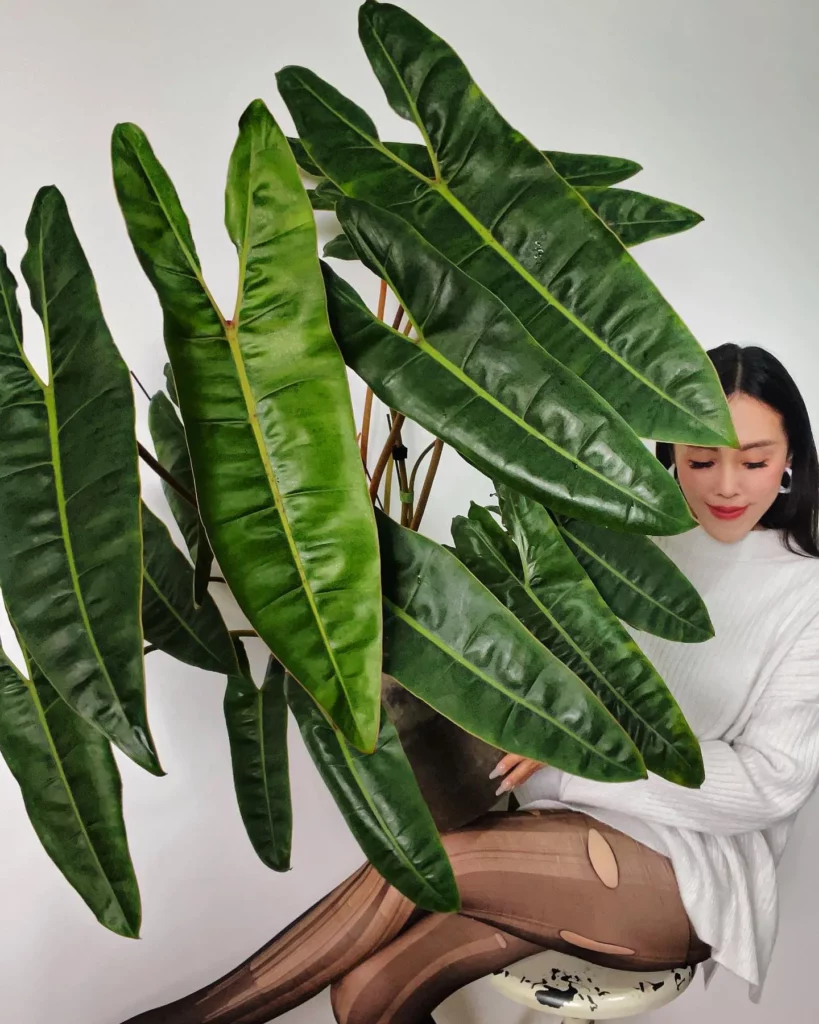
The Philodendron Billietiae is an outstanding choice for indoor plant enthusiasts, renowned for its distinctive appearance and low maintenance needs. This plant adapts well to various indoor light conditions, from low to bright indirect light, making it versatile for different home or office environments. It requires moderate watering, simplifying its care. Philodendron Billietiae is also known for its air-purifying properties, enhancing the quality of indoor air. Its unique and eye-catching foliage adds an exotic touch to any space, making it a popular choice for adding a natural, decorative element indoors.
- Long, Narrow Leaves: The leaves are elongated and narrow, offering an elegant and sleek appearance.
- Bright Orange to Yellow Petioles: The stems (petioles) of the leaves are a striking orange to yellow color, providing a vibrant contrast to the green foliage.
- Prominent Leaf Venation: Each leaf showcases distinct venation, adding texture and visual interest to the overall appearance of the plant.
Philodendron Bipennifolium

The Philodendron Bipennifolium is an excellent choice for indoor environments, known for its unique foliage and adaptability. It flourishes in a variety of light conditions, from low to bright indirect light, accommodating different indoor spaces with ease. This plant is relatively easy to care for, requiring only moderate watering and occasional feeding, making it suitable for plant lovers of all skill levels. Additionally, its air-purifying capabilities enhance indoor air quality. The Philodendron Bipennifolium’s distinctive leaf shape adds a touch of exotic elegance to any room, serving as a striking decorative element.
- Horsehead or Fiddle-shaped Leaves: The leaves have a unique shape, often compared to a horse head or a fiddle, making it a conversation starter.
- Large, Glossy Leaves: The foliage is large and glossy, adding a vibrant, lush look to indoor spaces.
- Deep Green Color: The leaves are a rich, deep green, contributing to the plant’s overall lush and tropical appearance.
Lemon Lime Philodendron

The Lemon Lime Philodendron is a popular indoor plant, cherished for its striking color and ease of care. Its ability to thrive in a range of light conditions, from low to bright indirect light, makes it highly adaptable to various indoor environments. This plant is also known for its air-purifying qualities, effectively removing toxins and improving indoor air quality. The Lemon Lime Philodendron requires minimal maintenance, with only occasional watering and feeding needed, making it an ideal choice for both novice and experienced plant enthusiasts. Its bright, cheerful foliage adds a lively splash of color to any indoor space.
- Vivid Lemon-Lime Colored Leaves: The foliage is characterized by a bright, lemon-lime color, bringing a vibrant and cheerful presence to any room.
- Heart-Shaped Leaves: Each leaf is heart-shaped, adding a touch of charm and warmth to its appearance.
- Cascading Growth Habit: The plant exhibits a trailing or cascading growth pattern, perfect for hanging baskets or shelves where it can gracefully drape.
Philodendron Rugosum

The Philodendron Rugosum is a superb choice for indoor settings, thanks to its unique appearance and low maintenance needs. This plant is adaptable to various light conditions, thriving in anything from low to bright indirect light, making it suitable for different indoor locations. It requires moderate watering, which is manageable for most plant owners. The Philodendron Rugosum is also appreciated for its air-purifying qualities, helping to cleanse the indoor air of pollutants. Its distinctively textured leaves add an element of rare beauty to any interior space, making it a fascinating and attractive addition to home or office environments.
- Puckered or Wrinkled Leaves: The foliage has a unique, puckered or wrinkled texture, giving it a distinctive and intriguing appearance.
- Deep Green Color: The leaves exhibit a deep green hue, adding a lush and vibrant touch to indoor spaces.
- Large, Oval Leaves: The plant features large, oval-shaped leaves, contributing to its bold and striking presence.
Philodendron Rojo Congo

The Philodendron Rojo Congo is a fantastic choice for an indoor plant due to its robust nature and striking appearance. This plant thrives in a range of indoor lighting conditions, preferring medium to bright indirect light, but it’s also tolerant of lower light levels. It’s known for its easy care, requiring only moderate watering and occasional feeding, making it suitable for both beginners and experienced plant enthusiasts. The Rojo Congo’s air-purifying abilities enhance indoor air quality, and its bold, colorful foliage adds a touch of exotic elegance to any interior space.
- Rich, Burgundy-Colored New Leaves: New growth emerges in a striking burgundy color, adding a unique contrast to the plant’s overall greenery.
- Broad, Glossy Leaves: The leaves are large, broad, and have a glossy finish, contributing to the plant’s lush and vibrant appearance.
- Sturdy, Upright Growth: Unlike many other philodendrons, the Rojo Congo has a strong, upright growth habit, making it a statement piece in indoor plant collections.
Philodendron Brandtianum

The Philodendron Brandtianum is an excellent indoor plant, renowned for its distinctive foliage and adaptability to indoor environments. It thrives in medium to bright indirect light but is also tolerant of lower light conditions, making it a versatile choice for various indoor settings. This plant is relatively easy to care for, requiring only occasional watering and feeding, appealing to both seasoned plant enthusiasts and beginners. Its air-purifying qualities improve the indoor air quality, and its ornate leaves add a touch of natural artistry to any room, enhancing the aesthetic appeal of home or office spaces.
- Silver Splashed Leaves: The foliage is adorned with silver splashes or streaks, creating a striking contrast against the dark green background.
- Heart-Shaped Leaves: Each leaf has a charming heart shape, contributing to the plant’s elegant and welcoming appearance.
- Cascading or Climbing Habit: The Philodendron Brandtianum exhibits a versatile growth pattern, capable of trailing or climbing, making it suitable for hanging baskets or climbing structures.
Philodendron Goeldii
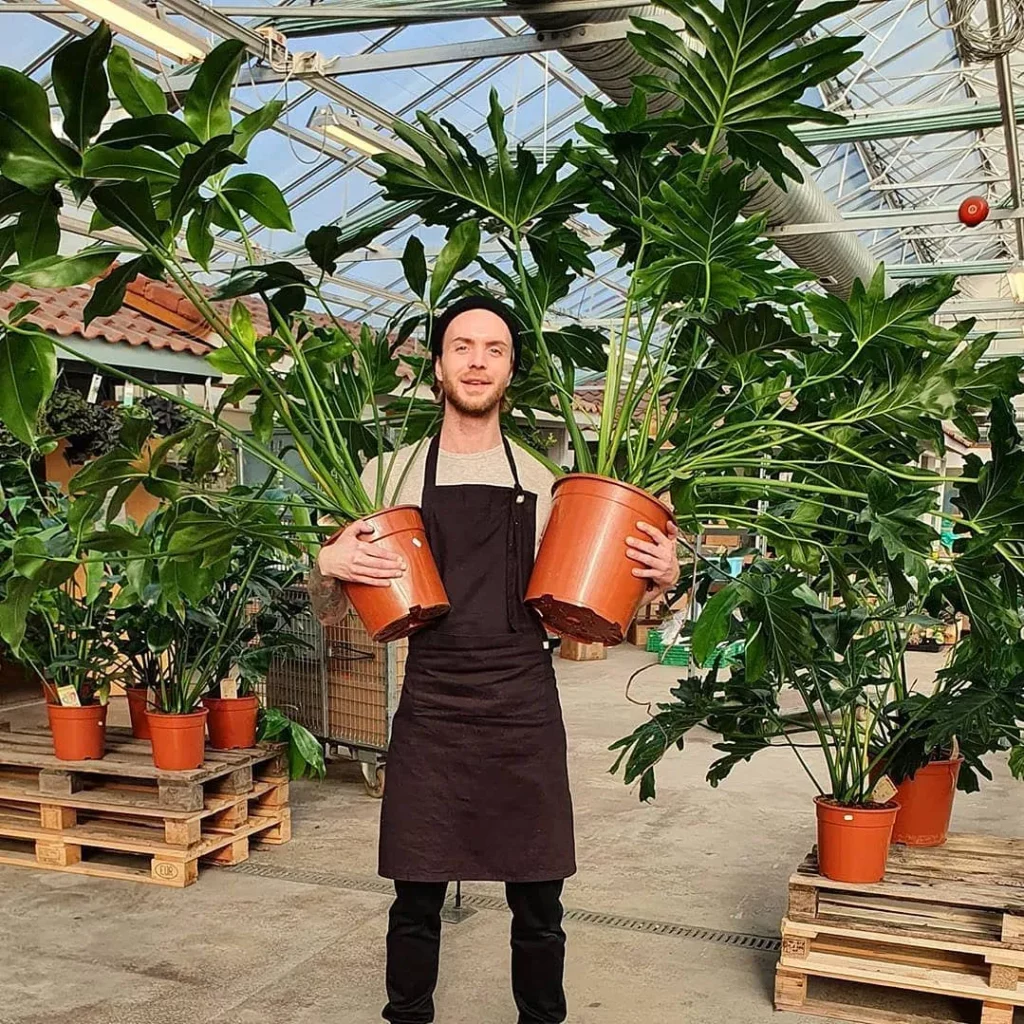
The Philodendron Goeldii is a remarkable choice for indoor planting, primarily for its unique spiral growth pattern and ease of care. It flourishes in indirect light, making it suitable for a variety of indoor settings, including those with limited natural light. This plant requires moderate watering and occasional feeding, appealing to both novice and experienced plant owners. Its air-purifying properties make it a healthy addition to indoor environments. The Philodendron Goeldii’s distinctive foliage and growth habit add an element of architectural interest to any room, making it a fascinating and stylish focal point.
- Spiral Growth Pattern: The leaves grow in a spiral fashion around the central stem, creating an eye-catching and architectural display.
- Finger-like Leaf Shape: The leaves are long and slender, resembling fingers, adding to the plant’s unique and striking appearance.
- Vibrant Green Foliage: The foliage is a bright, lush green, bringing a lively and refreshing feel to indoor spaces.
Philodendron Verrucosum
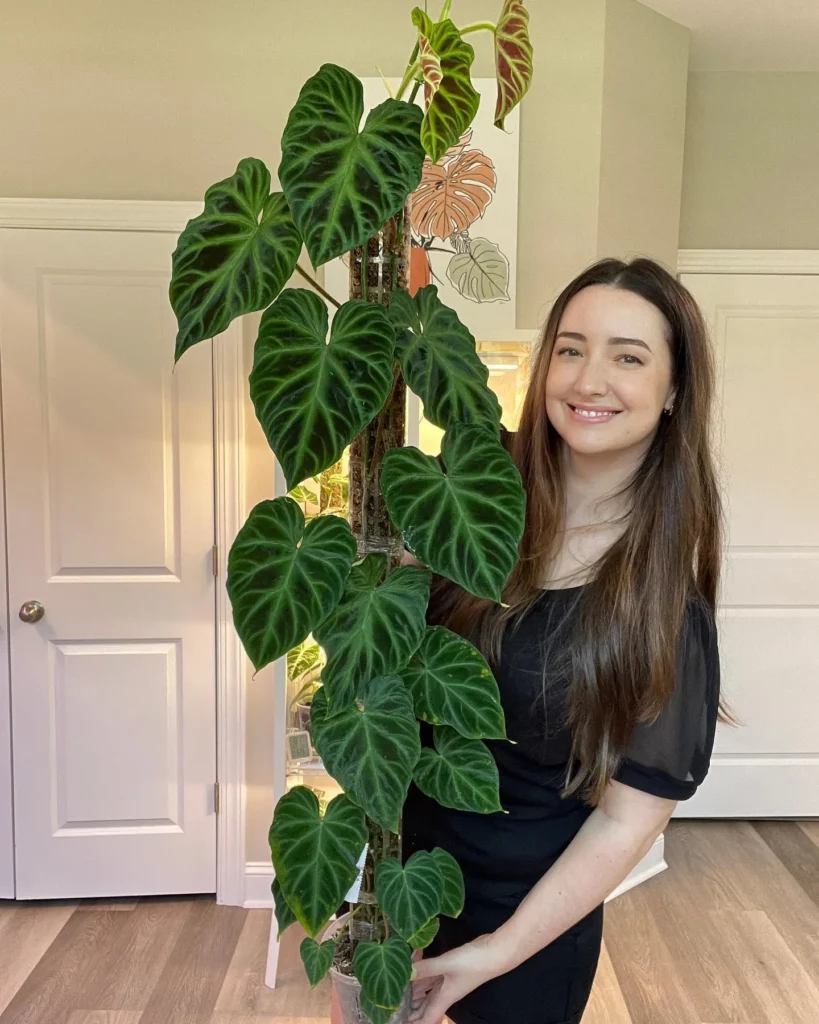
The Philodendron Verrucosum is highly valued as an indoor plant due to its exotic appearance and adaptability to home environments. It thrives in medium to bright indirect light, which is common in many indoor settings, making it a versatile choice for different room conditions. This plant is relatively easy to care for, needing only regular watering and occasional feeding. Its large, velvety leaves not only add a touch of the tropics to indoor spaces but also help purify the air, making it both a decorative and functional addition to any home or office.
- Velvety, Deep Green Leaves: The foliage is velvety and deep green in color, giving it a luxurious and lush appearance.
- Prominent Reddish-Orange Veins: The leaves feature striking reddish-orange veins, creating a dramatic contrast against the dark green backdrop.
- Hairy Petioles: The petioles (leaf stems) are covered with fine hairs, adding an unusual textural element to the plant’s overall aesthetic.
Philodendron Pink Princess

The Philodendron Pink Princess is a coveted indoor plant, beloved for its unique variegated leaves and ease of care. This plant thrives in medium to bright indirect light, but is also adaptable to lower light conditions, making it suitable for various indoor spaces. Its moderate watering needs and resilience to common pests simplify maintenance, appealing to plant enthusiasts of all levels. The Pink Princess is particularly valued for its striking pink variegation, adding a splash of color and a touch of whimsy to any indoor setting, making it a favorite among houseplant collectors and interior decorators.
- Pink Variegated Foliage: The leaves exhibit beautiful variegation with shades of pink, creating a striking and unique appearance.
- Glossy, Heart-Shaped Leaves: Each leaf is glossy and heart-shaped, adding an element of elegance to the plant’s overall look.
- Varied Leaf Patterns: The variegation on each leaf is unique, resulting in a diverse and visually interesting display of foliage.
Philodendron Cordatum

The Philodendron Cordatum is an ideal indoor plant, renowned for its heart-shaped leaves and low maintenance requirements. It flourishes in a variety of lighting conditions, from low to bright indirect light, making it adaptable to different indoor settings. This plant’s ease of care, including moderate watering and feeding, makes it suitable for both novice and experienced plant enthusiasts. Additionally, its air-purifying properties help to improve indoor air quality, making it a healthy and attractive addition to any home or office environment.
- Heart-Shaped Leaves: The leaves are charmingly heart-shaped, lending a romantic and soft aesthetic to the plant.
- Deep Green Foliage: The foliage is a rich, deep green, contributing to a lush and vibrant appearance in indoor spaces.
- Trailing Growth Pattern: The plant exhibits a cascading or trailing growth habit, perfect for hanging baskets or high shelves where it can gracefully drape down.
Philodendron Xanadu
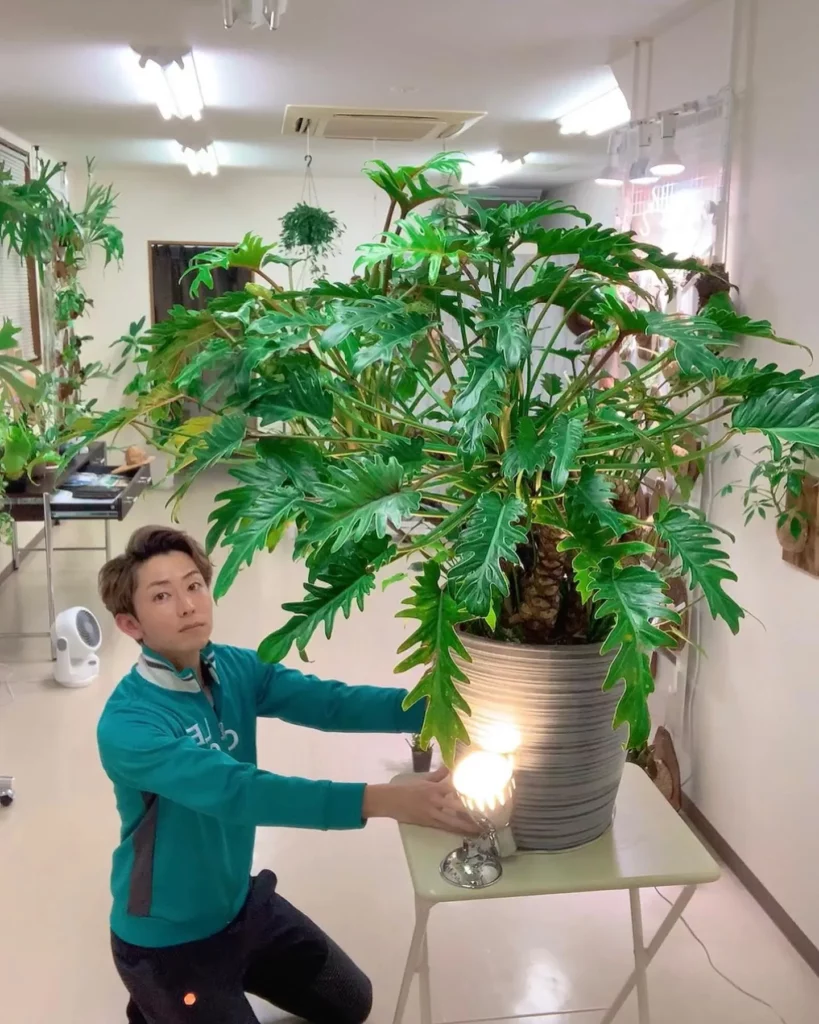
The Philodendron Xanadu stands out as an excellent indoor plant due to its unique, tropical aesthetic and low maintenance requirements. It adapts well to a range of indoor lighting conditions, thriving in everything from low to bright indirect light. This makes it versatile for various home or office spaces. The Xanadu is also known for its air-purifying qualities, which help to create a healthier indoor atmosphere. Its relatively compact size and ease of care, requiring only moderate watering and occasional feeding, make it a popular choice among both novice and experienced plant enthusiasts.
- Dense, Split Leaves: The foliage features dense, deeply split leaves, adding a lush and exotic texture to indoor spaces.
- Wide, Spreading Growth: The plant has a wide, spreading growth habit, creating a full and robust appearance.
- Vibrant Green Color: The leaves boast a vibrant green hue, enhancing the fresh and tropical feel of the plant.
Further reading on Philodendron: Types of Philodendron & Philodendron Ring of Fire Care Guide

